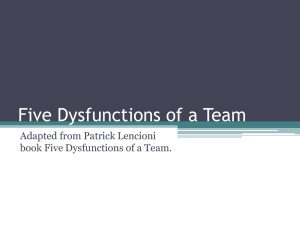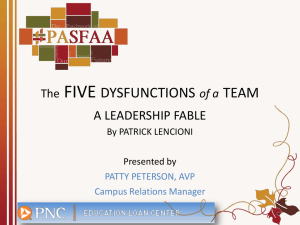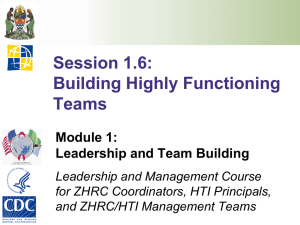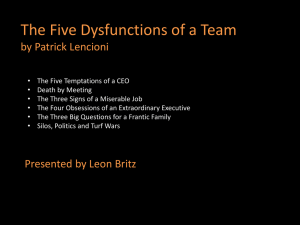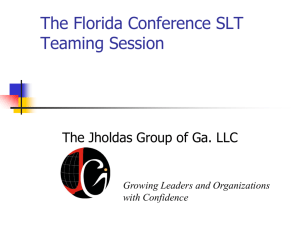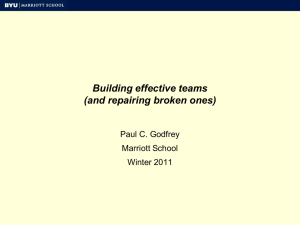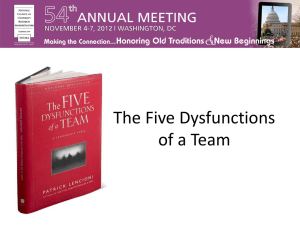Document
advertisement
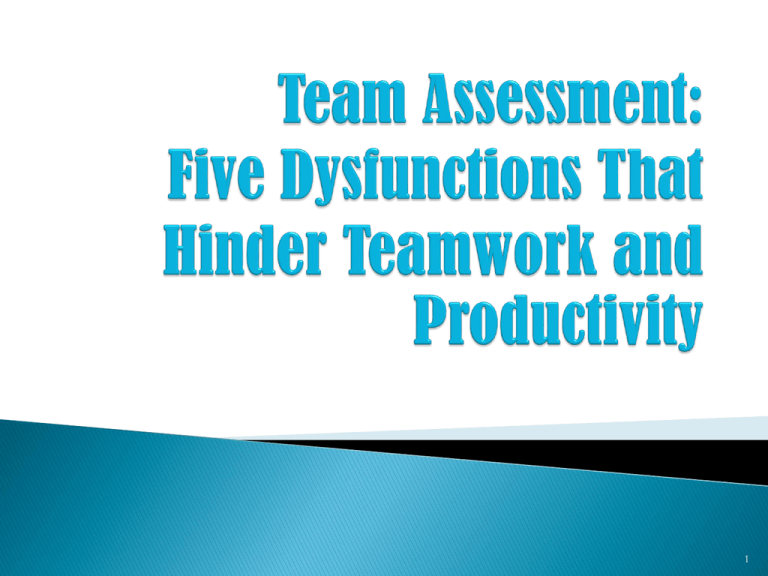
1 2 Inattention to Results Avoidance of Accountability Lack of Commitment Fear of Conflict Absence of Trust 3 Members of Teams with an absence of trust… Conceal their weaknesses and mistakes from one another Hesitate to ask for help or provide constructive feedback Hesitate to offer help outside their own areas of responsibility Jump to conclusions about the intentions and aptitudes of others without attempting to clarify them Fail to recognize and tap into one another’s skills and experiences Waste time and energy managing their behaviors for effect Hold grudges Dread meetings and find reasons to avoid spending time together 4 Members of Trusting teams… Admit weaknesses and mistakes Ask for help Accept questions and input about their areas of responsibility Give one another the benefit of the doubt before arriving at a negative conclusion Take risks in offering feedback and assistance Appreciate and tap into one another’s skills and experiences Focus time and energy on important issues, not politics Offer and accept apologies without hesitation Look forward to meetings and opportunities to work as a group 5 Teams that fear conflict… Have boring meetings Create environments where back-channel politics and personal attacks thrive Ignore controversial topics that are critical to team success Fail to tap into all the opinions and perspectives of team members Waste time and energy with posturing and interpersonal risk management 6 Teams that engage in conflict… Have lively, interesting meetings Extract and exploit the ideas of all team members Solve real problems quickly Minimize politics Put critical topics on the table for discussion 7 A team that fails to commit… Creates ambiguity among the team about direction and priorities Watches windows of opportunity close due to excessive analysis and unnecessary delay Breeds lack of confidence and fear of failure Revisits discussions and decisions again and again Encourages second-guessing among team members 8 A team that commits… Creates clarity around direction and priorities Aligns the entire team around common objectives Develops an ability to learn from mistakes Takes advantage of opportunities before competitors do Moves forward without hesitation Changes direction without hesitation or guilt 9 A team that avoids accountability… Creates resentment among team members who have different standards of performance Encourages mediocrity Misses deadlines and key deliverables Places an undue burden on the team leader as the sole source of discipline 10 A team that holds one another accountable… Ensures that poor performers feel pressure to improve Identifies potential problems quickly by questioning one another’s approaches without hesitation Establishes respect among team members who are held to the same high standards Avoids excessive bureaucracy around performance management and corrective action 11 A team that is not focused on results… Stagnates/fails to grow Rarely defeats competitors Loses achievement-oriented employees Encourages team members to focus on their own careers and individual goals Is easily distracted 12 A team that focuses on collective results… Retains achievement-oriented employees Minimizes individualistic behavior Enjoys success and suffers failure acutely Benefits from individuals who subjugate their own goals/interests for the good of the team Avoids distractions 13 Dysfunction #1: Absence of Trust ◦ Personal Histories Exercise ◦ Team Effectiveness Exercise ◦ Personality and Behavioral Preference Profiles Myers Briggs Type Indicator (MBTI) ◦ Experiential Team Exercises Ropes Courses, etc. 14 Dysfunction #2: Fear of Conflict ◦ Acknowledge that Conflict is productive ◦ Mining Assign a “miner of conflict” ◦ Real time permission Awareness of conflict, and reminding those who have reached the “uncomfortable” phase of a disagreement that what is happening is necessary. 15 #3: Lack of Commitment ◦ Cascading Messaging Review of decisions at conclusion of meetings and agree on what the next steps are to be. ◦ Deadlines Clear deadlines for when decisions will be made or projects completed. Removal of ambiguity. ◦ Contingency and Worst Case Scenario Analysis Know how you’ll react to changes. Talk about ‘worstcase’ scenarios ahead of time. ◦ Low Risk Exposure Therapy Practice decisive decision making in “low risk” situations. 16 Dysfunction #4: Avoidance of Accountability ◦ Publication of Goals and Standards Remove ambiguity by publishing goals and standards ◦ Simple and Regular Progress Reviews Team members should regularly communicate with one another with verbal and written feedback. ◦ Team Rewards Focus on a team concept. Remove individualism. 17 Dysfunction #5: Inattention to Results ◦ Public Declaration of Results Teams willing to commit publicly are more likely to work passionately toward accomplishing goals. “We’ll try” or “We’ll do our best” is a set up for failure. ◦ Results Based Rewards Tie rewards (i.e., compensation) to results 18 The reality of this is that teamwork ultimately comes down to practicing these principles over a long period of time. Success is not a matter of mastering subtle, sophisticated theory, but embracing common sense with uncommon levels of discipline and persistence. Teams that are successful succeed because they are exceedingly human. They acknowledge the imperfections of being human. Members of functional teams overcome the natural tendencies that make trust, conflict, commitment and accountability and a focus on results so elusive. 19 “Gettin' good players is easy. Gettin' 'em to play together is the hard part.” -Casey Stengel 20
